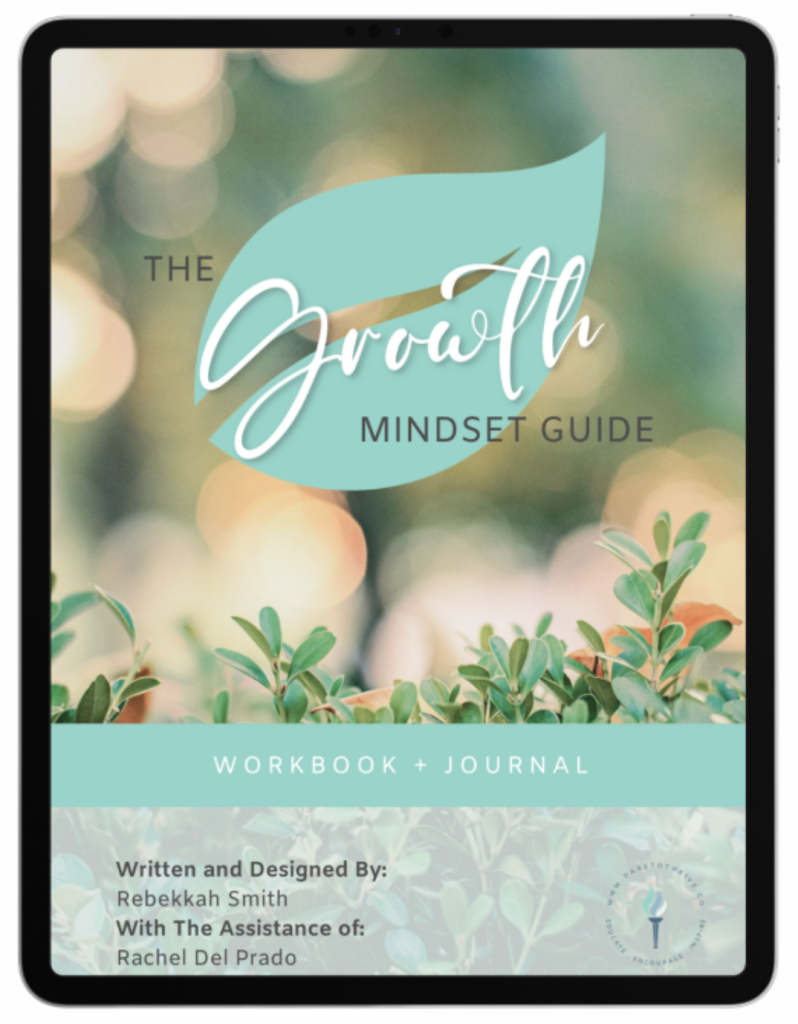Welcome to part two of How To Develop a Growth Mindset. In this article, we’ll going to learn how to create realistic goals for developing a growth mindset.
If you haven’t read part one, you can read it here. In the last post, we talked about what a growth mindset is and the importance of learning new skills for developing a growth mindset and for life in general.
Like I said in the last post,
“With any goal in life, there are skills we need in order to actually achieve those goals. I like to say that most things in life are skills and skills can be learned. So, if you’re new to this growth mindset stuff, being nervous or skeptical is normal. You’re literally at the beginning of learning a new skill (in this case many skills) that will result in you becoming the kind of person you envision yourself becoming and living the life you envision yourself living.”
QUICK DISCLAIMER: Because there’s already a million articles and videos out there that talk about goals, what they are, and why they’re important, I’m not going to talk about that here. Instead, I’m going to share my simple system for creating realistic goals that you’ll actually want to stick with.

What is Goal Mapping™
So, first of all, what is goal mapping anyway? It’s a super simple system I created to help me achieve my own goals. I’ve also shared a looser version of this system when helping others figure out how to create their own realistic goals.
Goal Mapping is simple. It’s where you take the 4 D’s that you’ll learn next and a notebook for journaling and reflection. Then, you take your goal and break it down into simple, digestible steps. What I like to call small wins.
Once you’ve outlined or Mapped your plan for achieving your goal, then it’s time to actually get started. In an upcoming article, I’ll teach you how to take your Goal Map and use it effectively with my simple Plan, Prep, Do™ system.
Now that you have the basics, let’s jump into the 4 D’s for Goal Mapping™.
The 4 D’s of Goal Mapping™
 1. Define your why
1. Define your why
This is something we see all over the internet today. Whether if it’s for weight related goals, career advancement, even parenting and relationships. We see everyone and their mother telling us to choose our why.
The reason I’m starting with this one is because it’s actually super imperative for any kind of goal achievement, even psychological ones. When we understand why we want to do something, it gives us the motivation to keep trying when we feel like giving up. Let me give you an example.
I don’t always want to sit at my desk and write blog articles. In fact, when it came time to start writing this one, it took me a while to get into the headspace I needed in order to focus and get the creative juices flowing.
I had to remind myself why I’m doing this. Why I decided to start this blog in the first place. It’s my why and reframing my perspective around blogging that helped me to get into the flow I’m in now.
Defining you why doesn’t need to be overly complicated.
Ask Yourself Questions Like:
- What’s the one thing that always bugs me about the way that I think about things or view the world?
- What’s the thing that typically fuels arguments with my spouse or kids or anyone?
- Do I like the way I feel after these experiences?
If the answer is no to that last question, then you need to ask yourself what do you desire to feel and get out of those interactions? In what ways do you want to improve your relationships or even your reactions to life situations?
You may need to grab a notebook and pen and write out some thoughts. Pray on these questions and ask the Lord to help you to see where you’re lacking in love and kindness.
The Lord is really good about revealing to us where we fall short. Just keep in mind that when He does, you need to be willing to accept those answers and then ask Him to give you the strength and courage to pursue change.
2. Determine Your #1 Priority/Objective
When learning any new skill, it’s super important to determine the main thing you want to get out of that skill. In this case, we
want to establish the number one priority or your objective for learning to have a growth mindset. This actually corresponds with your why.
Why do you want to develop a growth mindset and what do you want to get out of it?
Ask yourself questions like:
- Do I want to improve my communication skills?
- Am I happy with how my loved ones perceive/view me?
- Do I want to be more open-minded when my spouse, child, or someone presents an idea to me?
- What behaviors from others bother me that I actually do?
- Do I want to judge less and listen more?
By asking yourself questions like these, you’re training your brain to think more critically about who you are (aka, building self-awareness). By setting a baseline for building self-awareness, you’re creating the foundation for personal growth.
There are a few things to keep in mind here.
- Building self-awareness (getting to know yourself) is a life-long journey and journeys are not easy, they have treacherous terrain, highs and lows, and come with great amounts of growing pains. Are you willing to deal with these things?
- Building self-awareness often comes with unwanted feedback. So rather than dismiss it (like you normally would) it’s vital to your growth that you embrace that feedback and ultimately seek it out. Are you willing to ask your loved ones for feedback and actually consider what they have to say?
- Building self-awareness requires you to dig deep into your mind, emotions, and memories, and ask yourself questions that you may feel very uncomfortable asking, let alone answering. This is where I would recommend seeking professional guidance if you hold a lot of unresolved traumas that are at the root of your current way of being. Are you willing to dig into things that you’ve buried and that may come with a lot of hurt and baggage in order to begin healing and finally grow?
Building self-awareness with the goal of developing a growth mindset is not easy. You have to be intentional about it. So, when it comes to determining your number one goal for developing a growth mindset, you’ll have to be willing to do some self-reflection and possibly some major digging and healing in order to get to where you want to be.
3. Decide when you’re going to get started
Deciding when you’re going to get started on this journey to developing a growth mindset is just as important as the journey. The number one thing I want to encourage you with here is to not be afraid to start today.
Don’t feel like you have to wait until Monday, next month, or the new year. Those are arbitrary start dates and don’t actually help you begin in the right headspace.
If you’re not quite ready to start your intentional journey today, don’t worry. I do, however, encourage you to pick a date and put it in your calendar.
Let’s say you need some time to prepare, gather some resources, maybe even find a therapist, counselor, or life coach. It might take a few weeks to get yourself prepared.
That’s ok.
This preparation time will actually help you succeed in the long-term. This doesn’t mean that if you’re ready to start you can’t because you haven’t prepared. On the contrary, if you’re ready to start today, please do.
Why? Because you’ve already done a lot of the necessary mental preparation that is needed to be mentally and emotionally equipped for this journey.
If you need time to prepare, it’s not a bad thing, it simply means you’re not mentally or emotionally equipped just yet. The best part, though, you can get there! So, pick a random date on the calendar and set an appointment for getting started.
4. Direct Your Journey
Whether you’re getting started today or choosing to wait while you prepare yourself, making a plan is key to succeeding on this journey.
What you put in your plan will be completely different from what someone else puts in their plan, but the objective remains the same: giving yourself direction for your journey.
If you’ve ever done a road trip or simply gone somewhere you’ve never been, you’ve probably used some kind of GPS to get to your destination in a timely manner. Think of your plan as your GPS.
Your plan is going to direct you on your journey to developing a growth mindset and is going to help you stay on track when you feel lost, get tired, or lose sight of why you’re doing this.
Your plan should support your why and your priority. If it doesn’t, it’s not going to help you and you will give up. When creating your plan, you should include your ultimate goal, at least 3 milestones, and no more than 3-5 small tasks for each milestone.
By breaking down your plan into bite size tasks, you’re creating an environment for small, sometimes quick, wins that allow you to feel a sense of accomplishment.
Here’s an example of a simple plan to develop a growth mindset:
DISCLAIMER: This example was based on my own experience being on the giving and receiving end in a yelling household growing up. I used to yell so much and, growing up, yelling was normal. Thank the Lord my mom couldn’t stand yelling and determined in herself that she would set the example and help us all (including my dad) to learn how to communicate peacefully. If I were to ask her to review the example, I know she would agree that it is a great guide for helping someone to strategically change the unwanted behavior.
Goal #1 Priority: Yell Less When I Don’t Feel Heard
What will this achieve?: A more peaceful home. Better relationships with my loved ones. Reduce my anxiety and stress.
- Milestone 1: Begin healing my relationships.
- Task 1. Begin making amends with those I’ve hurt. Share my commitment to improve with those I trust to hold me lovingly accountable.
- Task 2. When I feel like yelling, practice pausing and taking a moment to breathe.
- Task 3. Practice apologizing quickly after I mess up and remember that messing is part of being human.
- Milestone 2: Practice what I preach.
- Task 1. Practice calmly telling the kids to stop yelling. If I model the positive behavior, eventually they’ll start seeing the difference and want to do it too.
- Task 2. Work on going a whole day without yelling and be ready to apologize when you do.
- Task 3. Work on going a whole week without yelling and be ready to apologize when you do.
- Milestone 3: Increase my confidence.
- Task 1. Reflect on my progress and see if new adjustments need to be made.
- Task 2. Ask my loved ones for kind, loving, honest feedback about my progress. Be ready for anything because this could be painful to hear.
- Task 3. Reflect on my progress by asking other close friends and family how I’m doing as compared to before. Also be ready for anything because this could be painful to hear.
I’ve simplified this example for the sake of this blog post. I’ll dive deeper into this example and the self-coaching you can use in an upcoming video, so make sure you’re subscribed to my channel that way you don’t miss it.
Closing Thoughts
I really hope this article was helpful to you. If it was, please let me know in the comments below. I’d love to receive your feedback so that I can improve the type of articles I share on this blog.
If there’s anything you would add to this article, please feel free to share in the comments so we can start a conversation about developing a growth mindset.
If you enjoyed this part 2, then be sure to check out part 3 where I share 6 Mindset Shifts and Skills For Achieving a Growth Mindset.
















